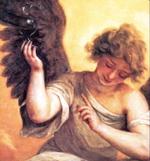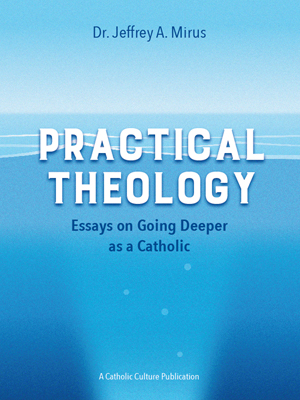The Irish Madonna of Hungary
by Zsolt Aradi
The veneration of Our Lady unites men all over the world in love, homage and supplication. It is not surprising therefore that an image of her which is dear to the hearts of one nation calls forth a sense of brotherhood and reverence in a far distant land. It is almost as if these images formed the material links in a vast chain of prayer. So the Irish Madonna of Hungary has joined two nations.
There is a touching custom among the inhabitants of the Hungarian town of Gyor and the villages located in the vicinity. This custom has been kept alive ever since the seventeenth century, particularly among the deeply religious peasantry. When a boy or girl is old enough to undertake a long march on foot, sometimes of from fifteen to twenty miles, the child is accompanied by his parents to the diocesan cathedral in Gyor and there dedicated by them to the Madonna whose picture now adorns the main altar. This Madonna is called the "Irish Madonna" because it was brought during troubled times of Cromwell's rule from Ireland, and has played a considerable role not only in the life of the immediate region but is connected with important historical events both in Hungary and the country of its origin.
Hungarians attach great importance to this picture of the Madonna because it comes from another country whose people have also fought and suffered for their faith. There are many other pilgrim places and shrines of the Madonna in Hungary, for ever since the tenth century the country has been dedicated to her and she is considered its patroness. The veneration of Mary is indeed ingrained in the Hungarian national character. A small nation, living for many centuries among peoples not related to them by ties of blood, the Hungarians have gone through continuous spiritual and material struggles and have a strongly developed sense of loneliness and tragedy. For them the Madonna is particularly the comforter of the afflicted and the protector of Christians.
The sorrow of the Eastern European peasant can reach depths sometimes unimaginable to the Western mind--as it can also reach the heights of joy. It is a common sight to see one of those millions submerged in personal or national sorrow wiping away his tears before the Madonna and rising up with a smile on his lips. The Madonna is the Mother of everyone in those regions. She is the one who in times of adversity comforts their souls and teaches them to hope and smile again. With the Hungarians, as with many other Eastern Europeans, one of the most important events in their religious life is a sign from the Madonna that she is with them. Thus there is a legend that the picture of the Madonna in Andocs, a village in Southern Hungary, was brought to its present location by two angels flying day and night, and at a time when the people of this region needed to be reassured that their Mother had not deserted them.
The extraordinary story of the Irish Madonna in Gyor, however, is not a legend but appears as a reality based on fact and the testimony of reliable witnesses. This picture hung in the Cathedral of Clonfert, in the diocese of Tuam, when in 1649 England dispatched Oliver Cromwell on a punitive expedition to Ireland and the religious persecution began. Walter Lynch, Bishop of Clonfert, and some of his fellow prelates were arrested and herded to an island called Innisboffin, where they were imprisoned. Bishop Lynch always carried with him the picture of the Madonna from Clonfert Cathedral, fearing that this treasured relic might fall into impious hands. In 1652, with some members of his group he succeeded in escaping to the Continent, where the Irish refugees were warmly received in various countries by their brothers who enjoyed a better lot. Bishop Lynch spent some time in Belgium and in Portugal. Later on he traveled as far as Hungary, for what reason we do not know, although he was doubtless acquainted with the close medieval ties that bound that nation to his own. And indeed he was received with open arms at the first bishopric he reached after crossing the Hungarian border. This was the city of Gyor, where the Hungarian Bishop appointed him as his auxiliary and he was made a member of the diocesan chapter. The Irish Bishop learned Hungarian and worked ten years among the faithful, but although grateful for the hospitality he received, his heart still longed for his native country. Thus, after ten years when the persecution in Ireland had subsided, he prepared with great expectation for his return journey. However, God decided otherwise. The Irish prelate fell suddenly ill and died in Hungary. On his deathbed he bequeathed the picture of the Madonna to the Bishop of Gyor, who placed it in the cathedral. Bishop Lynch himself is buried in the cathedral crypt.
The people of Gyor and its vicinity admired the picture, which came from a faraway land and felt it was divine intervention that had brought and left the treasured relic in their custody. Her arrival had marked a series of their victories over the Turks, and during the years many came to pray before the Madonna; it was felt that many national disasters had been averted through her intercession.
In 1697 the Hungarians enjoyed greater peace than they had known for many years. But during that year in Ireland, a greater blow than ever was to fall upon Bishop Lynch's coreligionists. In that year Parliament passed an edict that all priests were to be expelled from the territory of Ireland and from all the British Isles, the churches confiscated and all traces of the Catholic religion wiped out. A national Irish church was established and the dead could only be buried by ministers of that religion.
On March 17, 1697, Saint Patrick's Day, as thousands were praying during early morning Mass in the Cathedral of Gyor, priests and faithful suddenly saw that the eyes of the Madonna on the picture donated by the Irish prelate were shedding tears and blood, which dropped down upon the Child in the crib over which she was bending. This miracle lasted more than three hours. The face of the Madonna was wiped with linen (this linen is still preserved in the Cathedral of Gyor), but the blood and tears did not cease to flow. The picture was immediately taken from the wall and removed from its frame; the phenomenon continued. News of the marvel immediately spread to the far corners of the city and not only Catholics, but Protestants and Jews flocked to see the miracle. It was witnessed by thousands, and many of them gave testimony of what they saw. A document signed by more than a hundred persons bears the signature of the imperial governor of the city, the mayor, all the councilmen, the Bishop, some priests, Calvinist and Lutheran ministers and a Jewish rabbi--all of whom, volunteered to give their testimony to an undeniable fact.
The miracle of the Irish Madonna on St. Patrick's Day in 1697 remained deeply inscribed in the hearts of many Hungarians. Since that time the people have come to her shrine in times of personal sorrow and during the many disasters that have afflicted their country. There they have found strength in their despair, and their sorrow has been changed to hope.
This item 3052 digitally provided courtesy of CatholicCulture.org






